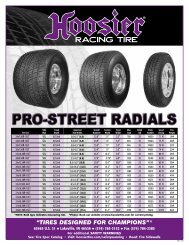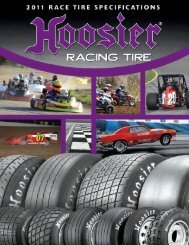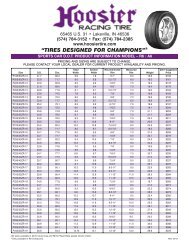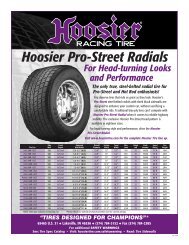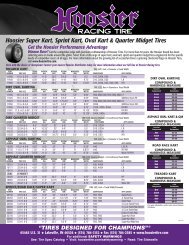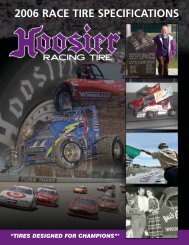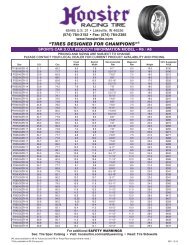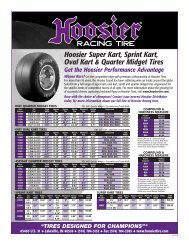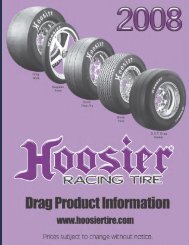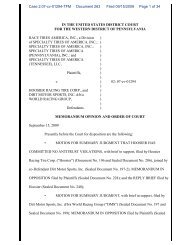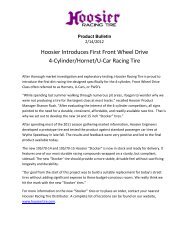tires designed for champions - Hoosier Racing Tire
tires designed for champions - Hoosier Racing Tire
tires designed for champions - Hoosier Racing Tire
- No tags were found...
Create successful ePaper yourself
Turn your PDF publications into a flip-book with our unique Google optimized e-Paper software.
TIRE PRESSURE RECOMMENDATIONS<strong>Hoosier</strong> <strong>tires</strong> typically require higher pressures than other brands. Autocross applications require higher ranges of pressure; roadracing tends toward the lower end of the recommended pressures.Reference the following chart <strong>for</strong> suggested pressures:Vehicle Size Recommended Hot Pressure Cold Pressure1800-2200 lbs. 39-42 30-362200-2600 lbs. 40-43 31-372600-3000 lbs. 42-46 32-37over 3000 lbs. 43-48 32-38Higher pressures will improve the per<strong>for</strong>mance capability but will require a more sensitive feel to take advantage of the increase.One characteristic of the <strong>Hoosier</strong> P-Metric radial <strong>tires</strong> is the tendency to “skate” initially (when inflation pressures are correct). It isimportant to resist lowering the pressure to eliminate this feeling. Dropping the pressure may improve the “feel” of the tire howeverit will also lower the per<strong>for</strong>mance and increase the wear on the tire, particularly on the outside tread edge.The above chart is a general recommendation that is intended <strong>for</strong> a standard configuration vehicle (i.e. front engine, rear wheeldrive). Factors that can radically affect your pressure set up would include front wheel drive, independent rear suspension, rearengine,McPherson vs. control arm front suspension.Front Wheel DriveVehicles configured with FWD are probably the most difficult application <strong>for</strong> a tire setup. The combination of steering, braking andaccelerating on the front <strong>tires</strong>, combined with higher corner weights <strong>for</strong> the front positions produce a harsh environment <strong>for</strong> the tire.These vehicles will typically have a strut type of suspension that limits camber gain. All these factors result in conditions that requirethe <strong>tires</strong> to do more work than a simple chart <strong>for</strong> pressures can accommodate.In severe cases front tire pressures <strong>for</strong> FWD vehicles can run in the 48-52 psi (hot). In cases where the tire size is limited to arelatively small tire, the required pressure can run even higher. The front to rear pressure differential on FWD cars can have extremeranges of inflation, depending on the driver preference, suspension tuning, and track configuration.Independent rear suspensionWith IRS and proper geometry up front, tire pressures can be reduced from the recommendations listed above. When there isadequate camber gain and good roll control, the <strong>Hoosier</strong> radial tire will per<strong>for</strong>m well at the reduced air pressure. This results in abigger “sweet spot” and easier control at the limit.When tuning at reduced pressures use the following <strong>for</strong>mula to determine the minimum safe pressure: Divide the total vehicleweight, including fuel and driver, by 100 to arrive at the minimum safe pressure. Example: Your car weights 2750 lbs. as raced.The minimum safe (cold) tire pressure is 27.5 psi.Extreme care should be taken when tuning at reduced pressure. <strong>Tire</strong> damage can occur that is not visible to external inspection.Vehicles equipped with independent rear suspension (IRS) have a distinct advantage over non-IRS cars when using radial <strong>tires</strong>.This is true <strong>for</strong> two reasons. First, it is possible to setup some amount of static negative camber on IRS suspension, if needed.Second, the IRS geometry can provide the proper camber gain to achieve the dynamic camber needed <strong>for</strong> a radial tire. This is agreat benefit because it then becomes possible to better address front tire grip when the rear of the car can be optimized closer tothe tire’s potential.“TIRES DESIGNED FOR CHAMPIONS” ®
THINGS TO CONSIDERThese <strong>tires</strong> are molded to their <strong>designed</strong> tread depth. They do not require shaving to be prepared <strong>for</strong> competition.Due to extremely light construction, <strong>Hoosier</strong> <strong>tires</strong> have a much lower polar moment than other radial <strong>tires</strong>. This translates to a verylow rotational mass, which is good <strong>for</strong> per<strong>for</strong>mance applications. The down side to this feature is that the <strong>tires</strong> do not resist “spikes”in braking <strong>for</strong>ce as a heavier tire might. As a result, there is a tendency <strong>for</strong> drivers to “flatspot” a tire the first time reallygetting to the limit. Vehicles equipped with ABS will benefit from its use. If you do not use ABS, it is recommended that you makean ef<strong>for</strong>t to minimize stabbing the brakes until you have some experience with the feel of the tire under hard braking.The light construction also provides less protection from impact damage and punctures. Off course excursions or running over debrison the track will likely result in tire damage.The <strong>tires</strong> are not directional. Once some wear has occurred it may be desirable to flip the tire on the wheel in order to even out thewear and maximize tire life.Wheel WidthsWheel width dramatically affects wear and per<strong>for</strong>mance of the <strong>Hoosier</strong> P-Metric radial <strong>tires</strong>.There is about a one-inch window of optimum width. The trick is to figure out that window. A good rule of thumb to use <strong>for</strong>determining proper width is to use the tread width of the tire. Measure the tread width. Plus or minus 1/2 inch from the tread dimensionwill indicate the proper rim sizing. It is possible to use narrower wheels, but at a sacrifice to shoulder wear and cornering power.“Measured” rim vs. “Recommended” rimIn our printed product catalogue and on our web site tire specifications you will see two columns of in<strong>for</strong>mation regarding rimdimensions. In most cases, the “measured rim” and the “recommended rim” will be the same. However in the case of DOT <strong>tires</strong>, thein<strong>for</strong>mation may appear contradictory.The reason <strong>for</strong> the differences lies in the Department of Transportation requirements <strong>for</strong> publishing tire dimensions on any tire thatcarries a DOT certification. Each tire size has a specific rim that must be used when taking measurements <strong>for</strong> tire comparison. Thisis intended to allow consumers a consistent way to compare tire sized between brands.With respect to the <strong>Hoosier</strong> P-Metric line, the recommended rim size will typically be wider than the DOT standardized wheel.The fact that a tire will “fit” on a rim is not an indication that it will work effectively in that condition. Radial <strong>tires</strong> are extremelysensitive to wheel widths. The per<strong>for</strong>mance characteristic of the tire can change significantly within the recommended range ofapplication. Mounting a tire on a rim that is outside of the recommendation is not a good idea.Driving Style/BrakingDriving style has also shown to significantly effect tire wear. Drivers who achieve their speed by “tossing” the car run the risk ofincreased tire wear. Radial <strong>tires</strong> develop their highest cornering power at relatively low slip angles. Smooth, tidy driving yields fasterlap times and better tire wear.The braking feel of the <strong>Hoosier</strong> R3S04 tire is vague at the threshold. This is particularly true <strong>for</strong> “sticker” <strong>tires</strong>. Drivers need todevelop a sensitivity <strong>for</strong> the limits under braking. This takes time and practice. Failure to apply this will result in flatspotted <strong>tires</strong>.Particular care needs to be taken when selecting brake pad compounds. It is possible to have a pad that is too aggressive. This willmake it very difficult to develop good braking feel <strong>for</strong> threshold braking.Rain <strong>Tire</strong>sThe <strong>Hoosier</strong> D.O.T. Radial <strong>tires</strong> are extremely good in dry conditions, however, they do not make very good wet weather <strong>tires</strong>.Having dedicated rain <strong>tires</strong> available will be necessary <strong>for</strong> your team to be properly prepared. <strong>Hoosier</strong> makes a D.O.T. approved biasplytire called a “Dirt Stocker” that has been proven to be far superior to any competitors tire as long as it is a steady “wet”condition. Check with your <strong>Hoosier</strong> representative <strong>for</strong> size availability.<strong>Hoosier</strong> <strong>Racing</strong> <strong>Tire</strong> offers a DOT Radial Wet tire. This tire has a molded tread of a symmetrical design. Check the product catalog<strong>for</strong> the available sizes. The compound <strong>for</strong> these <strong>tires</strong> is intended <strong>for</strong> wet weather use only.<strong>Hoosier</strong> also offers a non-DOT radial rain tire based directly on the P-Metric R3S04 tire. The tread depth is 8/32” and the pattern isthe same tread design found on the R3S04. They have been allowed in BMW Club racing and many other sports car clubs as well.Mounting instructions can be found in the “Road <strong>Racing</strong> FAQ” section of our web site. The list of available sizes can be found in the“road racing/tire specs” section of our web site.When using rain <strong>tires</strong>, always increase your starting air pressure 2-4psi over your dry tire pressures.“TIRES DESIGNED FOR CHAMPIONS” ®REV 3/04



